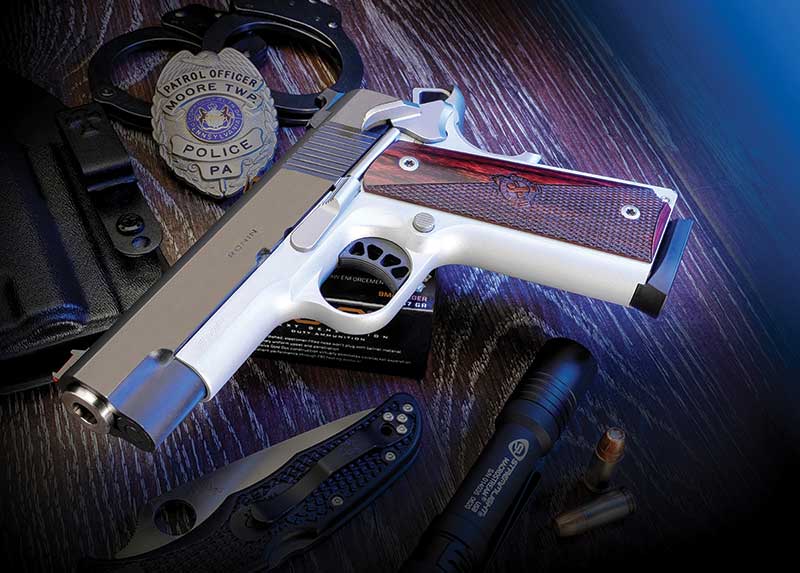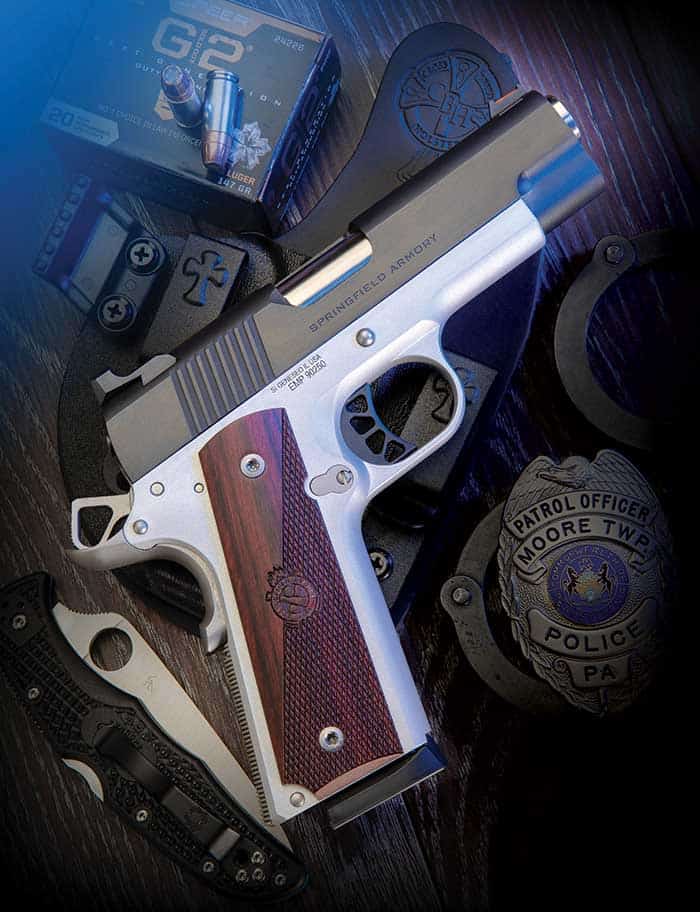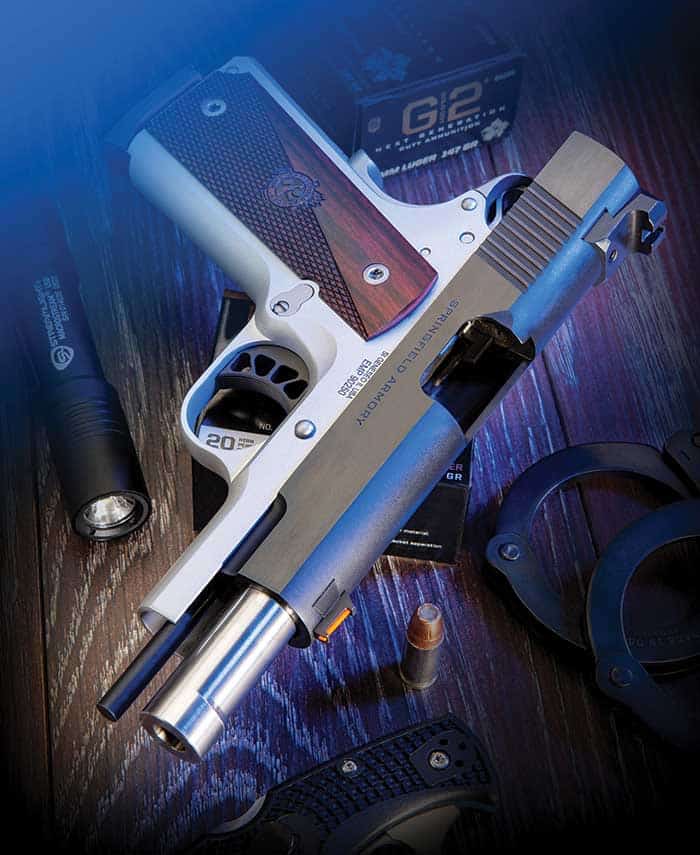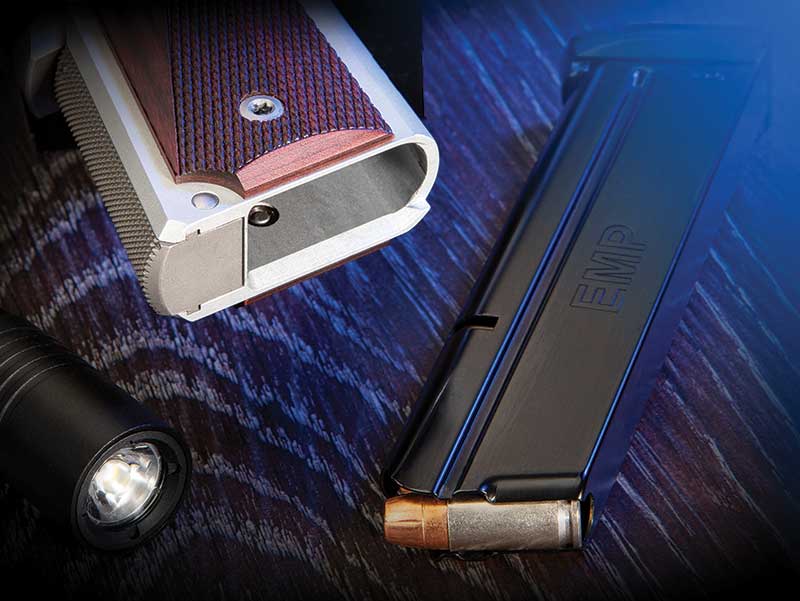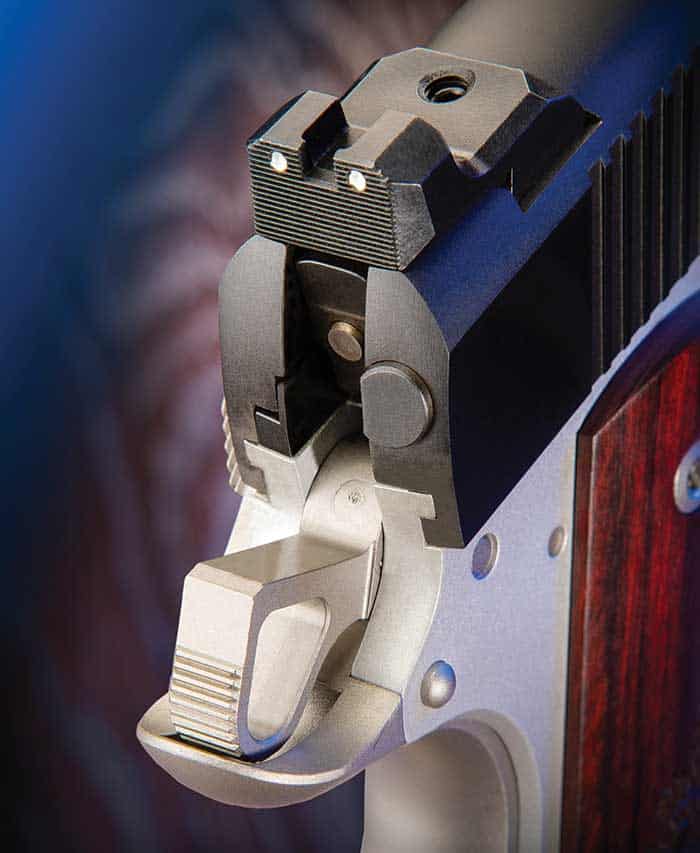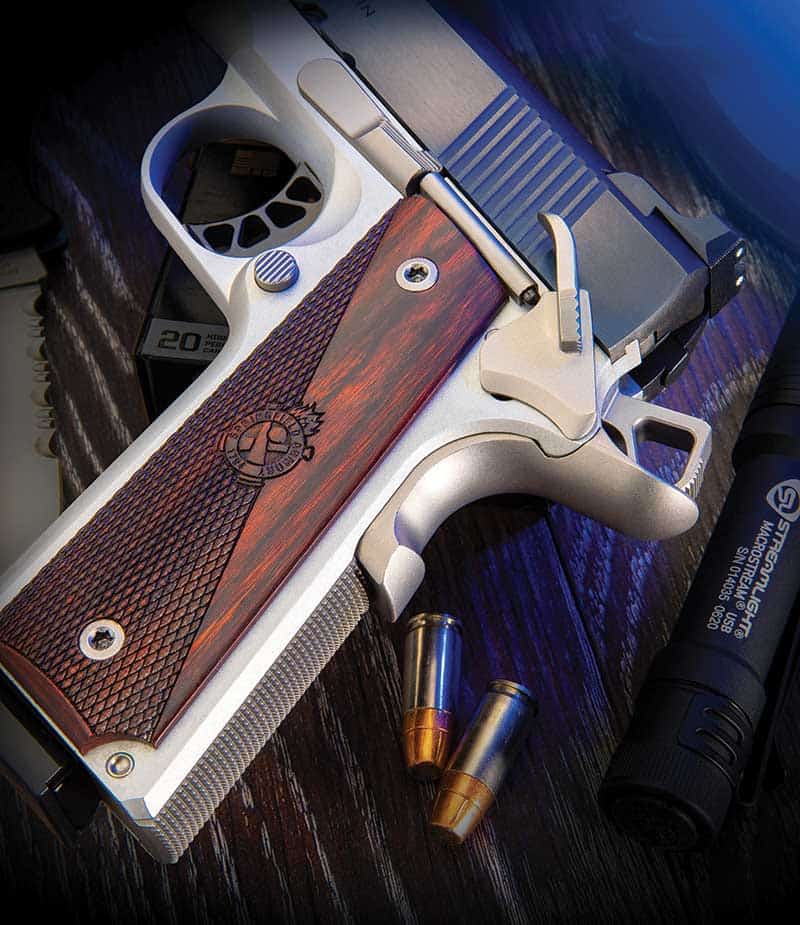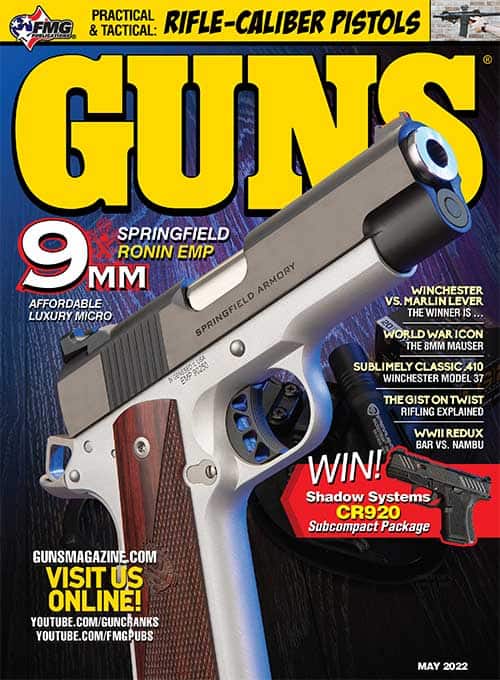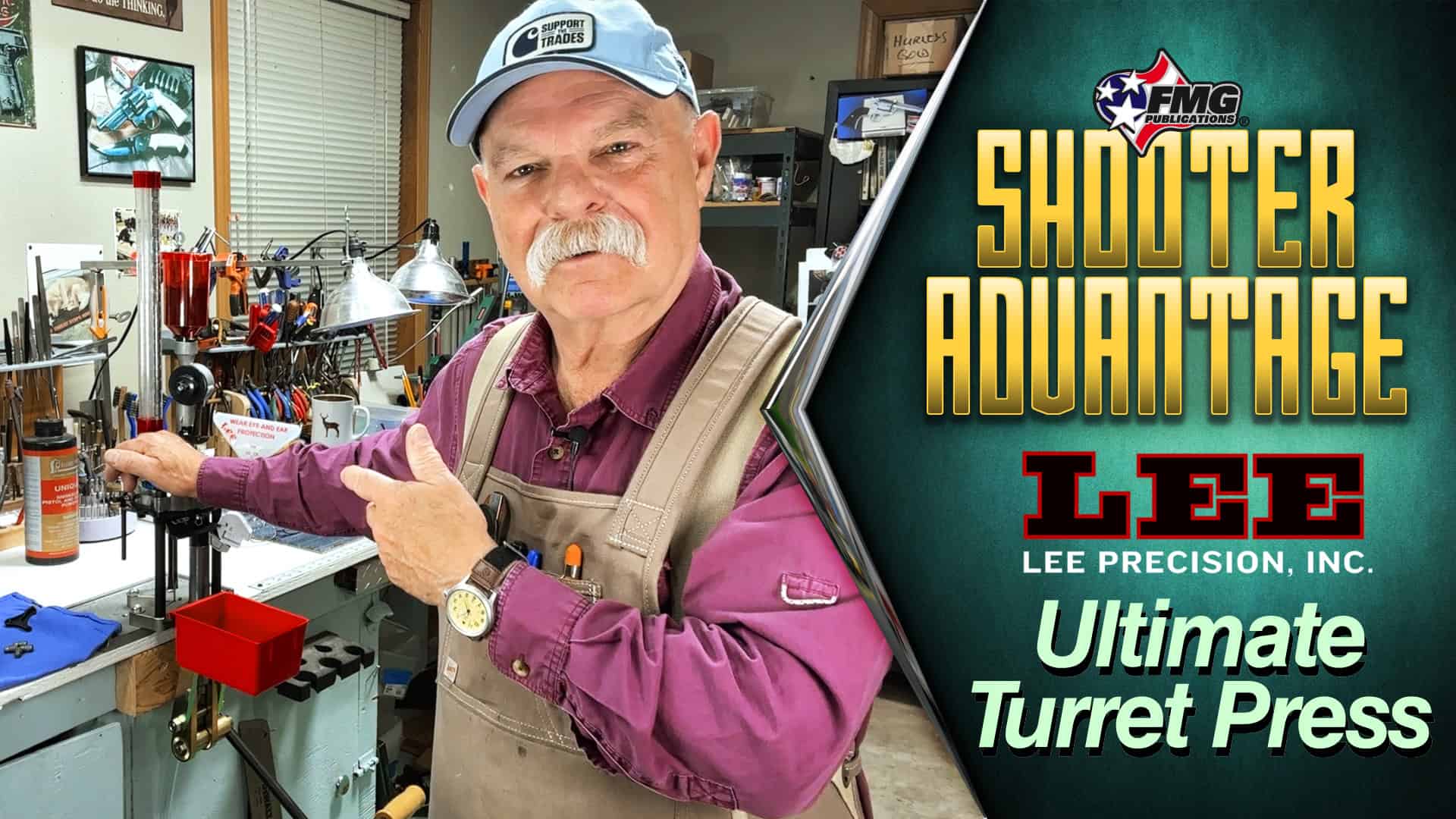Springfield Armory RONIN EMP
An Enhanced Micro Pistol You Can Afford
She stole it, and I can’t even press charges, in part because she’s my wife, and in part, because I had it coming.
The year was 2012. I was doing a story on the Springfield Armory EMP (Enhanced Micro Pistol) and its lineage to the 1911 TRP model. I had a loaner pistol sent my way — the original 3″-barrel 9mm model.
The original EMP may have “looked” like a scaled-down 1911, but inside is a lot of hidden engineering. The shortened frame allowed “proper” fit for shorter 9mm and .40 S&W cartridges. Everything in the EMP was built around the 9mm dimensions — no .45 ACP magazine spacer shortcuts. Springfield Armory patented the new ultra-reliable short-action design. The EMP has 17 unique parts compared to a standard 1911. So, while it looks like a 1911, acts like a 1911, and shoots like a very comfy 1911, it’s indeed optimized for caliber numbers less than 45. I didn’t try to see if it smelled like a 1911, but as an all-real-metal gun, I’ll bet it does.
Having recently purchased a Springfield Armory 1911 TRP, I figured the EMP would make a lovely complement for more discreet carry situations. I mentioned in passing my plan to go ahead and purchase the EMP to my bride, who had just seen the bill for my TRP, and she was nothing short of ecstatic. “Great! I’ve wanted a sweet carry pistol!” And there it’s been ever since. Men who’ve been married many years have mastered the art of shifting strategies on the fly. At least I still get to shoot it (almost) whenever I want.
Luxury Carry
It’s no stretch at all to call the original Springfield Armory EMP the “high end” of concealable carry guns, as the pistol was loaded with upgrades out of the box. While beauty truly resides in the eye of the beholder, most shooters I’ve encountered over the past nine years I’ve owned one appreciate the two-tone cosmetics — black hardcoat anodized aluminum frame topped with a brushed satin stainless steel slide. The use of aluminum and steel allows noticeable weight savings for concealed carry while maintaining the shooting feel of an all-metal pistol. A bushing-less bull barrel provides a nice balance to the medium-sized pistol.
The grips are Cocobolo. You know, the tropical hardwood derived from the heart of the Dalbergia retusa tree. They say you can hear the sound of waves crashing and a piña colada blender if you hold the grips up to your ear but there is a good reason high-end grips make use of Cocobolo. It’s a hard and durable wood loaded with oils that protect it from water, sweat and gun oil — and it looks fabulous. The wood grips were checkered except for the small diamond surfaces around each mounting screw and the Springfield Armory logo in the center.
The original EMP was loaded with all the extras, including ambidextrous safety, night sights, low-profile rear housing, three extra Mac-Gar steel magazines, a nifty case with holster and magazine carrier and other assorted gear. All of this ran the price tag up to an MSRP of just under $1,300. After, ahem, knowing someone in my immediate family who has owned one for nearly a decade, I can say it was worth the money. Slick, smooth, utterly reliable and it looks like a million bucks.
The Ronin EMP Generation
New to the EMP line is the Ronin version. Like other Ronin 1911 offerings, the design objective is straightforward — a solid pistol, offering the most critical functional features at an attractive price point. In other words, cut out the expensive parts considered luxuries more than necessities. The new Ronin EMP ships in your choice of a 3″ or 4″ barrel model.
Reduced and Redesigned
Like the original EMP, the Ronin contains far more engineering than a shortened barrel and slide from a standard 1911. Springfield engineers designed a slew of revised internal parts to make the 9mm work reliably and reduce grip circumference as the shorter 9mm cartridge allows. The Ronin contains a proprietary frame, slide, firing pin, firing pin spring, extractor, ejector, trigger, plunger tube, plunger tube assembly, grips and magazine.
Features & Differences
While the basic Ronin EMP design remains true to the original EMP, some differences exist. For starters, the color pallette of the frame and slide are reversed. The frame is still forged aluminum, but instead of black, it’s treated with a satin silver Cerakote finish. The slide is blued steel instead of stainless. The bull barrel is forged and features a fully supported ramp like the original.
You’ll notice the Ronin’s safety is single-sided on the left side of the frame. The grips are wood but not advertised as Cocobolo. The checkering covers about half of the surface and uses a diagonal division — reminiscent of cutting a yummy ham sandwich corner to corner. The crust stays on, thank you.
Capacity
Capacity varies with your choice of barrel length. The 3″ Ronin EMP features a single-stack magazine holding nine rounds of 9mm. Add one in the chamber for a total carry capacity of 10.
The 4″ Ronin EMP also uses a single-stack approach, but its taller grip gives you a little more space for ammo, so you’ll get 10 in the magazine plus an extra in the chamber.
All EMP magazines include a base extending slam pad — a nice touch for easy magazine insertion and handling. I suppose that’s also handy should you need to yank a magazine out of place. The steel mags drop freely in normal conditions, so only a serious malfunction would require a yank-and-tear operation. I haven’t had one of those in nearly a decade with the original, so I don’t expect to see them with the new generation either.
Do note that while the magazines are the same as with the original EMP, you’re only getting one in the box instead of three — one of the tradeoffs to make for a nearly $400 MSRP reduction. Hey, if you want to get the gun and save for more magazines later, I think it’s a swell way to spread out the cost.
Sights
While the original EMP included night sights, adding approximately $100 to the cost, the Ronin features a fiber optic front sight. It’s a dovetail mount, so you can either swap the red tube for a different color or replace the front sight altogether if you insist on Tritium. I’ve drifted away from Tritium as I’ve found fiber optics to be plenty visible unless it’s near pitch dark.
The rear sight is Springfield’s “quick rack” design, offering a ledge for one-handed slide racking on belts or other surfaces. The back surface is horizontally serrated to reduce glare distraction and contains two white dots flanking the center notch. The system is perfectly serviceable and I’ll likely be keeping this one as-is, at least until the Novak’s folks talk me into something swanky.
Trigger
The trigger is peachy right out of the box. There’s maybe 1/16″ of smooth and largely resistance-free take-up followed by slight back-pressure before a crisp break. I measured the weight right at 4.5 lbs. Interestingly, my original EMP still shares a near-identical trigger feel and a 4.5-lb. pull weight.
There are slight physical differences between the old and new Ronin EMP’s trigger. The original was constructed from aluminum while the new version uses a Nylon trigger face. There’s also an overtravel adjustment on the original EMP, which I’ve never used, but none on the Ronin, nor is there any detectable over-travel. This is another one of those minimal-value features left out to lower the price poin
Field Stripping
After removing the magazine and checking to ensure the chamber is clear, you need to compress the flat spring using an included Allen-wrench-like tool. It’s a round device (no flats) as its only purpose is to jam the short end into a hole in the guide rod to prevent the spring from expanding all the way. Once you remove the slide stop like any other 1911, you can pull the recoil assembly out from the back as the barrel slides out the front. If you lose the Allen-thingy, use a bent paper clip to perform the same function.
Shooting
I shot the Ronin EMP 4″ model using five different ammo types over several outings. As for subjective handling, I wasn’t disappointed. Even with the price-point-enhancing design changes, this pistol still shoots like a high-end model. The weight soaks up recoil, the action is smooth and I had no malfunctions of any kind. This one came straight out of the box, received no care, cleaning, or lubrication and went to work.
I mixed up bullet styles and weights to identify any obvious ammo sensitivities.
First up was Federal’s Syntech Defense load. This one sways toward the heavier side for 9mm, weighing 138 grains. The blue-polymer-coated bullet is designed to fragment into three distinct wedges upon impact. I’ve gel-tested it in the past and it does precisely that. From the 4″ pistol (as are all the following velocity and accuracy numbers), I measured its speed at 1,051 fps. From 15 yards, it was printing 2.0″ five-shot groups when shooting using the iron sights and a Ransom Multi-Caliber rest.
Next up, I checked out Federal 124-grain Training Match ammo. At 15 yards, I got an average of 1.59″ five-shot groups and an average velocity of 1,124 fps.
Black Hills HoneyBadger is a solid-copper projectile complete with novel cuts designed to violently displace fluid in targets much like a drill bit. As expected, they zipped right along, measuring 1,198 fps and printing 1.48″ groups at 15 yards.
Norma MHP 108-grain defensive rounds are designed for maximum expansion. They averaged 1,133 over the Competition Electronics ProChrono DLX and printed 2.25″ groups at 15 yards.
Last but not least, I finished up with some more traditional ammo, the Federal Punch 124-grain defensive round. This traditional jacketed hollow point bullet averaged 1,114 fps and printed five-shot groups of 1.43″.
If the EMP has been out of your financial reach, the Ronin EMP is your huckleberry. With some creative design tweaks and repackaging, Springfield Armory has knocked nearly $400 off the MSRP of the original EMP pistol. Coming in at $899, this Enhanced Micro Pistol is more accessible to shooters who want a high-end carry pistol. With eyes closed, one would be hard-pressed to feel the difference.
